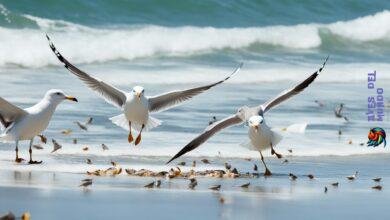Seagulls are not your average birds. They are fascinating creatures with unique qualities and adaptations that make them truly special. From their diverse species to their intelligent problem-solving skills, seagulls have captivated the attention of scientists and bird enthusiasts alike.
In this article, we will delve into the world of seagulls and uncover what sets them apart. Whether you’ve marveled at their scavenging abilities or wondered about their nesting habits, we’ve got you covered. So, join us as we explore the extraordinary world of seagulls and discover what makes them so intriguing.
Different Species of Seagulls
Seagulls, belonging to the genus Larus and the family Laridae, encompass a wide range of species found across the globe. These seafaring birds have diversified and adapted to various terrains and habitats, making them remarkable in their own right.
With their distinct characteristics and behaviors, seagull species showcase extraordinary versatility in their ability to scrounge for food, even in urban environments. Let’s explore a few notable seagull varieties and their unique adaptations.
1. Herring Gull
The herring gull (Larus argentatus) is one of the most recognizable seagull species, often seen in coastal regions of North America and Europe. These large birds have a wingspan of up to five feet and exhibit a distinctive white and gray plumage.
Herring gulls are opportunistic feeders, consuming a wide range of prey including fish, invertebrates, and even small mammals. They are known for their kleptoparasitic behavior, stealing food from other gulls and even humans, as they scavenge on beaches and near harbors.
2. California Gull
The California gull (Larus californicus) is a seagull species endemic to the western coast of North America, particularly in California. These birds are slightly smaller than herring gulls and have a pale gray body, white head, and yellow bill.
California gulls exhibit an interesting migratory behavior, nesting in the western United States during the breeding season and then migrating to coastal areas of Mexico during the non-breeding season. They mainly feed on insects, small fish, and even carrion.
3. Black-headed Gull
The black-headed gull (Chroicocephalus ridibundus) is a medium-sized seagull species found across Europe and parts of Asia. Despite its name, this gull doesn’t have a black head in its adult plumage; instead, it has a chocolate-brown hood.
Black-headed gulls are primarily inland birds, often seen near freshwater bodies and agricultural fields. They have a varied diet, feeding on insects, worms, small fish, and even grains. Their adaptability to diverse habitats allows them to thrive in both natural and man-made environments.
4. Laughing Gull
The laughing gull (Leucophaeus atricilla) is a seagull species predominantly found in coastal areas of North and South America. These medium-sized gulls have a black head, gray wings, and a distinctive red bill.
Laughing gulls are known for their unique vocalization, which resembles a raucous laugh hence their name. They predominantly feed on fish but are also opportunistic scavengers, often seen foraging on landfills and around fishing boats.
| Seagull Species | Habitat | Distinctive Features |
|---|---|---|
| Herring Gull | Coastal regions of North America and Europe | Large size, white and gray plumage |
| California Gull | Western coast of North America | Pale gray body, white head, yellow bill |
| Black-headed Gull | Europe and parts of Asia | Chocolate-brown hood, black head in breeding plumage |
| Laughing Gull | Coastal areas of North and South America | Black head, gray wings, red bill |
These are just a few examples of the diverse seagull species found worldwide. Each species has its own ecological niche, adapting to specific habitats and food sources. The versatility and adaptability of seagulls exemplify their resilience and ability to thrive in various environments.
Adaptations and Behaviors of Seagulls
Seagulls, with their remarkable adaptations and behaviors, have successfully thrived in a variety of environments. These adaptable birds, often referred to as «generalist feeders,» have found ways to take advantage of the ever-changing human landscape.
One of their notable adaptations is their ability to nest in unconventional locations, such as rooftops and chimney pots. By choosing these urban spots, seagulls can establish their nests closer to the abundant food sources available in cities and towns.
Seagulls exhibit impressive intelligence and learning capabilities, allowing them to develop and pass on successful behaviors to their offspring. Their complex communication system, composed of vocalizations and body movements, further enhances their ability to navigate their surroundings and coordinate within their social groups.
Seagulls’ intelligence and adaptability enable them to thrive in urban environments, nesting on rooftops and utilizing their communication skills to succeed in challenging human landscapes.
These birds play by the rules of survival in an ever-evolving world, constantly adapting their foraging strategies to secure sustenance. With their opportunistic feeding habits, seagulls sample various food sources they encounter, including insects, fish, plants, and even small rodents. This adaptability and willingness to try different foods contribute to their success as generalist feeders.
To illustrate the diverse behaviors and adaptations of seagulls, here is a table highlighting some of their key characteristics:
| Behavior/Adaptation | Description |
|---|---|
| Urban Nesting | Seagulls nest on rooftops and chimney pots in urban environments, taking advantage of food sources in cities. |
| Learning and Teaching Behaviors | Seagulls exhibit intelligence and can learn successful behaviors, passing them on to future generations. |
| Communication System | Seagulls possess a complex communication system using vocalizations and body movements. |
| Generalist Feeding | Seagulls are opportunistic feeders, consuming a diverse range of prey, including fish, insects, plants, and small rodents. |
As you can see, seagulls’ adaptations and behaviors have allowed them to thrive in various environments and successfully exploit the available resources. Their ability to adapt, learn, and communicate has secured their place in both natural and urban habitats.

Seagull Intelligence and Problem-solving Skills
Seagulls are not just opportunistic scavengers, but also intelligent creatures with remarkable problem-solving skills. Their ability to adapt to their surroundings and find innovative ways to obtain food sets them apart from other avian species.
Studies have shown that seagulls possess impressive learning abilities and can pass on feeding methods to their offspring. One notable example is their technique for breaking open hard-shelled mollusks. Seagulls have learned to drop these shells from a height onto hard surfaces, utilizing gravity as a tool to access the nutritious contents inside. This demonstrates their cognitive flexibility and ability to devise unique strategies for survival.
«Seagulls have proven their problem-solving skills by mastering techniques like dropping hard shells to access food. Their intelligence allows them to adapt to different situations and thrive.»
Furthermore, research has revealed that seagulls can understand human gaze direction. This means that they can interpret where humans are looking and use this information to their advantage. They are curious and quick to grasp opportunities presented by human activities, making them resourceful and adaptable in urban environments.
Seagulls also exhibit curiosity and an eagerness to solve tasks. They have been observed investigating novel objects and exploring their surroundings with inquisitive behavior. This cognitive curiosity contributes to their problem-solving abilities and showcases their higher-order thinking skills.
The Role of Seagull Intelligence in Survival
Seagull intelligence and problem-solving skills play a crucial role in their survival and adaptation. Their ability to respond to changing conditions and find efficient ways to secure food resources has contributed to their success in diverse environments.
Seagulls’ cognitive abilities are a result of their highly developed brains in proportion to their body size. This brain-to-body ratio is a valuable adaptation that allows them to process and retain information, make decisions, and learn from their experiences. It enables seagulls to quickly learn and adapt to new situations, further enhancing their problem-solving skills.
Understanding seagull intelligence and problem-solving skills provides valuable insights into the versatility and resilience of these fascinating birds. It highlights their unique cognitive abilities and their remarkable capacity to thrive in a variety of environments.
The Intelligence of Seagulls in Nature
The intelligence and problem-solving skills displayed by seagulls contribute to their survival and success in the wild. These adaptive traits allow them to exploit various food sources, withstand environmental challenges, and outcompete other species. Seagulls’ ability to understand and interact with their surroundings showcases their remarkable cognitive capabilities, making them a truly intriguing species to study.
Seagull Diet and Foraging Behavior
Seagulls are fascinating creatures when it comes to their diet and foraging behavior. They are well-known opportunistic feeders, willing to try almost any food they come across. This adaptability allows seagulls to sustain themselves in a variety of environments.
«Seagulls have mastered the art of kleptoparasitism, which involves stealing food from other gulls and even humans.»
Seagulls have developed diverse feeding strategies to survive in different habitats. Their diet includes a wide range of prey, such as cnidarians, fish, insects, plants, and even small rodents. These birds are skilled scavengers and are known to exploit landfills for food resources. Their ability to adapt to different food sources greatly contributes to their survival and widespread distribution.
Foraging Techniques
Seagulls employ various foraging techniques depending on the available food sources. They are capable of surface feeding, plunge diving, and aerial hawking. Surface feeding involves picking food items from the surface of water bodies, while plunge diving is utilized when hunting fish underwater. Aerial hawking refers to the behavior of seizing prey in mid-air.
Additionally, seagulls have exhibited innovative feeding behaviors, including «drop hunting.» They have been observed dropping shellfish from heights to break the shells and access the nutritious contents inside. This behavior showcases their problem-solving skills and the ability to adapt their feeding techniques to overcome obstacles.
Impact on Ecosystems
Seagulls play a vital ecological role in their respective ecosystems. Their voracious appetite for small prey species helps control population levels, preventing overpopulation of certain organisms. Furthermore, their scavenging behavior assists in nutrient cycling, contributing to the overall health and balance of marine and coastal ecosystems.
The Seagull Diet
Here is an overview of the primary food items found in the seagull diet:
| Food Group | Examples |
|---|---|
| Fish | Herring, mackerel, anchovies |
| Invertebrates | Crabs, clams, shrimp |
| Insects | Beetles, grasshoppers, flies |
| Plant Matter | Seeds, berries, grass |
| Small Mammals | Rats, mice |
Seagulls are truly versatile in their feeding habits, making them successful in diverse environments. Their foraging behavior and ability to adapt to different food sources are remarkable evolutionary traits that have contributed to their widespread distribution and survival as a species.

Seagull Nesting and Breeding Habits
Seagulls are remarkable birds that demonstrate strong family bonds and devotion in their nesting and breeding habits. These monogamous creatures mate for life, forming lifelong partnerships. The breeding season is an important time for seagulls as they prepare to raise the next generation.
During the mating season, seagulls engage in courtship rituals, showcasing their affections through elaborate displays of flight and calls. These displays not only strengthen the bond between mates but also signal their commitment to each other.
Once the connection is established, seagulls seek out suitable locations to construct their nests. These resourceful birds are known for their adaptability when it comes to nesting locations. Whether it be on serene beaches, flat roofs of buildings, or even in gutters, seagulls make the best use of the environment available.
The nests themselves are simple and purposeful structures. Seagulls utilize materials such as twigs, grass, and seaweed to create a comfortable haven for their offspring. The construction of the nest not only provides shelter but also acts as a visual marker, indicating occupation and defending their territory.
Seagulls typically lay an average clutch of three eggs, carefully incubating them to ensure their warmth and safety. Both parents take turns incubating the eggs, with each taking shifts lasting several hours. This shared responsibility highlights the commitment and cooperation between the mated pair.
Once the eggs hatch, the parents continue their diligent care, feeding the chicks with regurgitated food and protecting them from potential threats. Seagulls are protective parents, fiercely defending their nests from predators and other intruders.
Seagull Nesting and Breeding Habits
| Nesting Habits | Breeding Habits |
|---|---|
| Seagulls nest in various locations, including beaches, flat roofs, and gutters. | The breeding season is a time of courtship rituals and displays of commitment. |
| Nests are constructed using twigs, grass, and seaweed. | Seagulls lay an average clutch of three eggs. |
| Incubation of eggs is shared between both parents. | Chicks are fed regurgitated food by their parents. |
| Seagulls fiercely protect their nests and offspring from threats. | Devotion and cooperation between mated pairs are paramount. |
Seagulls in Urban Environments
Seagulls are not only found in coastal areas; they have also successfully adapted to urban environments, thriving amidst the hustle and bustle of cities and towns. Their remarkable ability to tolerate the various disturbances of urban life, including noise and human activity, is truly impressive.
Seagulls in cities have made the most of their cognitive abilities and large brain-to-body ratio, which have played a significant role in their adaptation to urban areas. This adaptability allows them to navigate and exploit the resources available in these environments, making them highly successful in urban settings.
Their survival in urban areas can be attributed to several factors. Firstly, seagulls have a diverse diet, which allows them to take advantage of the various food sources found in cities, such as discarded waste and leftovers. Additionally, their opportunistic nature enables them to scavenge effectively, making them adaptable to the urban feeding habits of both humans and other animals.
«Seagulls in urban areas have demonstrated their ability to thrive amidst the concrete jungle, showcasing their remarkable adaptability and intelligence.»
Seagulls have also found creative ways to nest in urban environments. They often choose flat rooftops, balconies, and even gutters as their nesting sites. This unique nesting behavior allows them to be close to their preferred food sources and away from potential predators commonly found in natural habitats.
The successful adaptation of seagulls to urban environments has led to an increase in their population in cities and towns. While this is an interesting phenomenon, it has also raised concerns about seagull-human interactions and potential nuisance. We will explore these aspects further in the next section.
Seagull Adaptation in Urban Environments
| Adaptation | Description |
|---|---|
| Feeding Habits | Seagulls take advantage of urban food sources, including discarded waste and leftovers. |
| Nesting Behavior | Seagulls adapt their nesting sites to urban structures, such as rooftops and balconies. |
| Tolerance to Disturbances | Seagulls exhibit a high tolerance to noise and human activity in urban areas. |
| Population Increase | The adaptability of seagulls has led to an increase in their population in cities and towns. |
Seagulls have adapted remarkably to urban environments, thriving amidst the challenges posed by cities and towns. Their ability to tolerate disturbances, exploit available resources, and adapt their nesting behavior have contributed to their success in urban areas.
Seagulls and Human Interactions
Seagulls, with their scavenging and stealing behaviors, can sometimes be perceived as a nuisance by humans. Local authorities and town councils have implemented measures to reduce the level of nuisance caused by seagulls, recognizing the need for effective management strategies.
One common approach to mitigating seagull nuisance is the banning of gull feeding. When individuals intentionally provide food for seagulls, it encourages their presence and can lead to increased aggressive behavior and dependency on human sources. By discouraging the feeding of gulls, communities aim to discourage their presence in residential areas and public spaces.
In addition to the nuisance they create, seagulls can also pose health and safety risks. Seagulls are known carriers of bacteria, including E. coli and Salmonella, which can potentially cause infections. Furthermore, their sharp beaks can cause injuries, especially when they defend their nests or food sources.
Efforts to manage seagull-human interactions go beyond banning feeding and encompass various methods. These may include installing bird deterrent systems, modifying building designs to discourage nesting, and implementing education campaigns to raise public awareness about responsible waste management and the potential risks associated with seagull behavior.
Protecting Public Health and Safety
The presence of seagulls in urban areas can impact the well-being of both residents and visitors. Preventing the spread of diseases and minimizing the risk of injury are essential considerations in managing seagull-human interactions. By implementing effective strategies, local communities can strike a balance between coexisting with seagulls and ensuring public health and safety.
It is crucial for individuals to be cautious when encountering seagulls, especially in areas where they are known to nest or congregate. Avoiding direct contact, not feeding them, and properly disposing of waste can help reduce the likelihood of negative interactions.
«Seagulls may be part of our natural environment, but it’s important to remember that they are wild animals with specific behaviors and needs. Respecting their space and implementing appropriate measures can help minimize any potential conflicts or risks.» – Dr. Jane Collins, Avian Biologist
The Ecological Role of Seagulls
Seagulls play a vital ecological role in their ecosystems, contributing to the balance and health of their habitats. One of their key functions is controlling the populations of small prey species, such as insects and fish. By preying on these organisms, seagulls help regulate their numbers and prevent overpopulation, which can have negative effects on the ecosystem as a whole.
In addition to regulating prey populations, seagulls also contribute to nutrient cycling through their scavenging behavior. They are adept at finding and consuming carrion, fish remains, and other organic matter, thus recycling nutrients back into the ecosystem. This process helps maintain the balance of nutrients in the environment and supports the growth of other organisms.
Understanding the ecological role of seagulls is essential for appreciating their importance in the natural world. These birds have a significant impact on the functioning of ecosystems, influencing both the abundance of prey species and the cycling of nutrients. By recognizing the ecological value of seagulls, we can better protect and conserve their populations and ensure the continued health and balance of our ecosystems.



